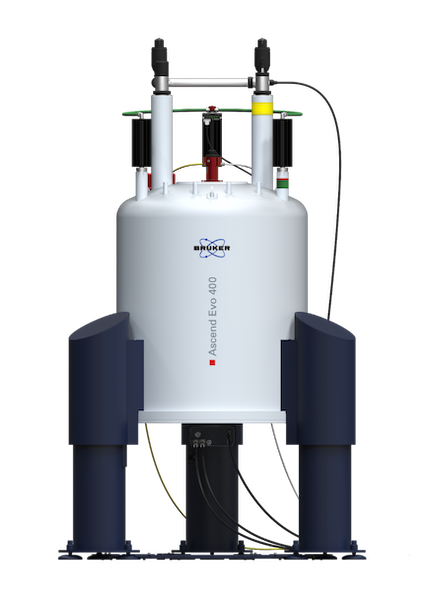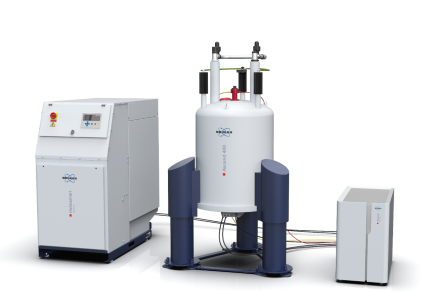Members Login

Channels
Special Offers & Promotions
Bruker Advances NMR Magnet Portfolio, Innovates in Industrial Solutions

Advancements in NMR enable deeper insights into life science, drug discovery, and cleantech
At the Experimental Nuclear Magnetic Resonance Conference (ENC 2023), Bruker announces innovations for NMR spectroscopy in life science, pharma, and cleantech research to enable discoveries in functional structural biology, drug discovery, and battery research.
Bruker launches the Ascend Evo 400 new standard 400 MHz NMR magnet with a liquid helium hold-time of one year to reduce cost of ownership and enhance operational convenience. This novel magnet also has improved field homogeneity with new cryogenic shimming technology originally developed for ultra-high field magnets, in order to make sample shimming and operation even easier.
This 400 MHz innovation joins the Ascend Evo 1.0 GHz with ~65% lower liquid helium consumption over previous 1.0 GHz magnets. In late 2022, the RIKEN Center for Biosystems Dynamics Research in Yokohama, Japan and the Universitat de Barcelona were first to receive Ascend Evo 1.0 GHz systems, which are already generating exceptional data. They complement Bruker’s Avance™ Neo 1.2 GHz systems with two-story 2 Kelvin magnets, which typically are shared at national NMR centers, as demonstrated by recent UK orders for two 1.2 GHz spectrometers for University of Warwick and University of Birmingham. These two 1.2 GHz systems enable life science research in functional and structural biology and improve greentech research infrastructure for plant biofuels, improving batteries, and solar cells.
 Bruker offer helium recovery with its HelioSmart-R, a compact system to collect helium gas boil-off from magnets. Bruker announces successful installations of the HelioSmart-R recovery solution in pharma labs of Merck in Darmstadt, Germany, as well as at the University of South Carolina, with many more installations of HelioSmart-R expected in 2023.
Bruker offer helium recovery with its HelioSmart-R, a compact system to collect helium gas boil-off from magnets. Bruker announces successful installations of the HelioSmart-R recovery solution in pharma labs of Merck in Darmstadt, Germany, as well as at the University of South Carolina, with many more installations of HelioSmart-R expected in 2023.
Perry J. Pellechia, Director of NMR Services and Professor at University of South Carolina, commented: “We are pleased to be the first US lab to benefit from HelioSmart-R. With this new concept for recovery, we save 80% of helium and convert it into liquid helium using the liquefaction facilities at our university. We look forward to more sustainable and cost-effective lab operations.”
The new HelioSmart-L solution for liquefaction, collects and liquifies helium gas boil-off from installed NMR magnets with over 95% recovery rate. HelioSmart-L collects steady-state losses from magnets during operations, as well as during helium refills, and then purifies and liquefies the helium creating a closed loop.
At ENC 2023, Bruker also introduces new industrial and pharmaceutical capabilities for the Fourier™ 80 benchtop FT-NMR platform. The new Fourier 80 X-optimized 1H/7Li system will be an essential tool for battery research to study atomic-level properties of lithium-containing materials critical for more efficient batteries.
Dr. Vick Singh, Director of Research & Development for Dragonfly Energy in Reno, Nevada, stated: "As we transition from fundamental materials development towards implementing new materials in prototypes and pilot lines, benchtop systems with lithium NMR can be a great tool.” Bruker and Dragonfly Energy collaborate on analytical instruments, including NMR, to accelerate Dragonfly’s pioneering battery technology research.
The new Fourier 80 1H/13C|19F system advances pharmaceutical research. 19F NMR is a powerful tool in drug discovery and development that provides information about chemical structure, formulation, safety, and toxicity of fluorinated drug molecules. This aids in optimizing efficacy, safety, and formulation of drug candidates.
Chemical engineer Philippe Robin, the CEO and co-founder of Alysophil SAS in France, explained: “'We demonstrated the first real-world solution in AI-powered autonomous chemical synthesis for APIs, within the PIPAc project, in collaboration with NovAliX, De Dietrich Process Systems and Bruker. The unparalleled selectivity of the 19F Fourier 80 will dramatically improve the process of AI deep learning with highest-quality analytical information.”
Dr. Falko Busse, President of the Bruker BioSpin Group, concluded: “We are delighted to introduce new innovations at this year’s ENC. Advancing cleantech research is very important to the future of our planet. I am excited to see what new scientific, pharma and cleantech advancements will be enabled by NMR technology.”
Bruker is enabling scientists to make breakthrough discoveries and develop new applications that improve the quality of human life. Bruker’s high performance scientific instruments and high value analytical and diagnostic solutions enable scientists to explore life and materials at molecular, cellular and microscopic levels. In close cooperation with our customers, Bruker is enabling innovation, improved productivity and customer success in life science molecular and cell biology research, in applied and pharma applications, in microscopy and nanoanalysis, as well as in industrial applications. Bruker offers differentiated, high-value life science and diagnostics systems and solutions in preclinical imaging, clinical phenomics research, proteomics and multiomics, spatial and single-cell biology, functional structural and condensate biology, as well as in clinical microbiology and molecular diagnostics.
Media Partners


